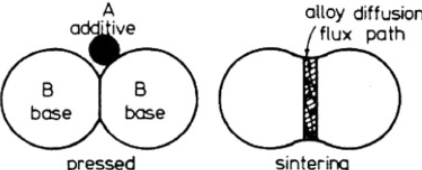Powder injection molding of biocompatible stainless steel biodevices
Author: Faiz Ahmad - July 2016
Muhammad Aslam, Puteri Sri Melor Binti Megat Yusoff, Khurram Altaf, Mohd Afian Omar, Randall M.German
Abstract
Although various materials have been exploited throughout history to restore damaged organs, metallic biodevices are preferred in the biomedical industry because of their superior ability to withstand high static or cyclic loads. An implant is a medical device manufactured to replace a damaged biological structure. Medical implants are manmade devices and their biocompatibility plays an important role in determine the life of inserted implant. This review presents previous research conducted in the field of corrosion resistance and mechanical properties of bioimplants made of 316L stainless steel (SS) powder using the powder injection molding process. It also establishes a motivational link between the past and present to encourage researchers to conduct constructive studies on the most problematic areas of bioimplants. This article presents a critical review on powder selection, manufacturing techniques, debinding processes, and sintering conditions of 316L SS powders. It also focuses on the influence of powder shape, powder size, powder-to-binder ratios and their effects on densification in terms of corrosion and mechanical properties. In this paper, practical densification approaches are divided into three categories: activation sintering, optimized solid loading, and bimodal mixtures. Additionally, suggestions for the formation of a passive oxide layer on the outer surface of 316L stainless steel implants using powder densification approaches and optimization of sintering parameters are proposed.
Methodology
To achieve quality standards for PIM parts, they should exhibit high density, good dimensional control, homogeneous properties and low manufacturing costs. Density is of primary concern for better performance and it is believed that when density increases all end product properties are improved. A number of techniques are practiced to enhance density including pressure sintering, double press compaction and other conventional processes. However, wider acceptance of these approaches is limited due to high costs and geometric changes in end products [102]. Densification plays an important role that determines material applications for biomedical implants, aerospace industrial components and other corrosion resistant requirements. 316L SS densification depends on several variables listed in Table 2 [103]. The densification process can be enhanced by using external force on samples or by providing highly active kinetic paths via the addition of second phase particles in the matrix [104].
Impact & Benefits
Strength and Corrosion Resistance: The use of metals ensures durability and reliability in medical applications, reducing the frequency of implant failures due to mechanical stress.
Machining Process: These microcracks can lead to implant failure, highlighting the need for better manufacturing techniques.
Cost-Effective: PIM is a more economical process for mass production
Intricate Shapes: It can produce complex geometries more easily than traditional powder compaction methods.
Optimized Densification: By controlling materials' shape, size, and sintering parameters, PIM can achieve optimized densification, resulting in homogeneous functional properties, finer grain size, and uniform distribution of metallic phases.
Findings/Figures and Research Data
The findings indicate that in the medical industry, metallic implants face significant challenges related to poor corrosion resistance and mechanical properties. Although non-metallic implants have been explored for their superior biocompatibility, metallic materials remain preferred due to their toughness, durability, and strength. Surface modification techniques to improve metallic implants have limitations, as these implants are still prone to corrosion from non-uniform, porous surface coatings. Specifically, 316L stainless steel implants rely on a non-porous passive film to prevent oxidation and corrosion. The quality of this passive film depends on the choice of 316L stainless steel powder and the sintering parameters during the metal injection molding process. The alloy composition, particularly the proportions of molybdenum, chromium, and nickel, and the sintering conditions such as temperature, time, and atmosphere, significantly influence the film's effectiveness. Improper conditions can lead to pitting corrosion, where pits can propagate and cause implant failure due to low densification. Thus, higher densification through bimodal and tri-modal powder systems and optimized particle size distributions is crucial. However, the link between densification and the formation of the chromium oxide film needs more exploration. Further experimental research is required to optimize particle size distribution and to correlate sintering parameters, particle shape, and size with densification and corrosion resistance in powder mixtures.
Market Potential
The market potential for addressing the challenges associated with metallic implants, particularly focusing on enhancing corrosion resistance and mechanical properties, is substantial. Despite efforts to replace metallic implants with non-metallic alternatives due to their superior biocompatibility, metallic materials remain preferred for their toughness, durability, and strength. However, the susceptibility of metallic implants to corrosion, exacerbated by non-uniform and porous surface coatings, underscores the need for advanced solutions. Processes that facilitate the formation of non-porous passive films on metallic implants, such as the selection of 316L stainless steel powder and optimization of sintering parameters during metal injection molding, present opportunities for improvement. Addressing factors like alloy composition, sintering conditions, and densification mechanisms is crucial to enhancing corrosion resistance and extending the lifespan of implants. Furthermore, exploring advanced powder systems and particle size distributions to achieve higher densification levels can mitigate the risk of failure due to corrosion-induced pitting. Despite the existing challenges, the demand for effective and reliable metallic implants in the medical industry remains high, offering significant market potential for innovative solutions that overcome these limitations. Experimental investigations aimed at optimizing particle size distribution, sintering parameters, and particle characteristics will be essential in unlocking this market potential and driving advancements in the field of metallic implants.


